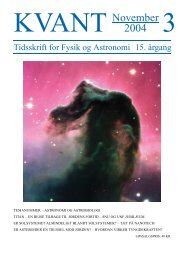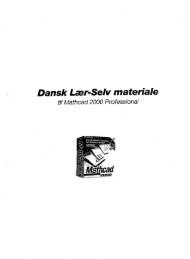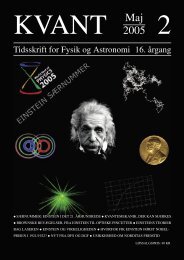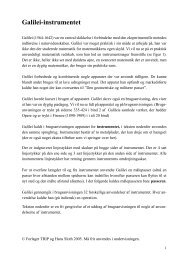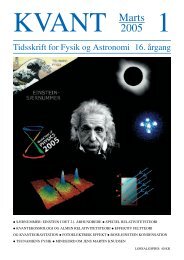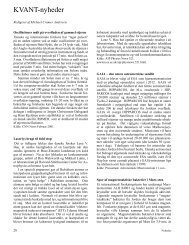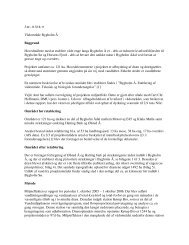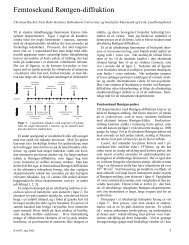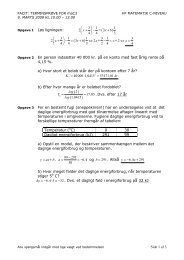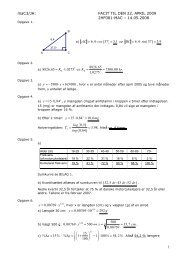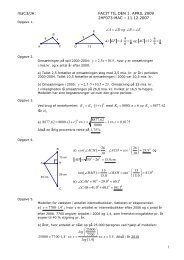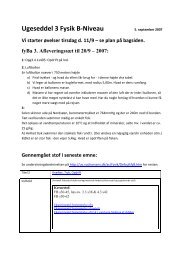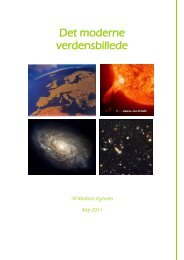Chapter 7 The Outer Planets
Chapter 7 The Outer Planets
Chapter 7 The Outer Planets
Create successful ePaper yourself
Turn your PDF publications into a flip-book with our unique Google optimized e-Paper software.
4<br />
202 <strong>Chapter</strong> 7 <strong>The</strong> <strong>Outer</strong> <strong>Planets</strong><br />
a<br />
To Jupiter<br />
5000 km<br />
b<br />
FIGURE 7-16 Jupiter’s Ring and Torus (a) A<br />
portion of Jupiter’s faint ring system, photographed by<br />
Voyager 2. <strong>The</strong> ring is probably composed of tiny rock<br />
fragments. <strong>The</strong> brightest portion of the ring is about 6000 km wide.<br />
<strong>The</strong> outer edge of the ring is sharply defined, but the inner edge is<br />
somewhat fuzzy. A tenuous sheet of material extends from the ring’s<br />
inner edge all the way down to the planet’s cloudtops. (b) Io’s torus<br />
(also called Io’s plasma torus because the gas particles in it are<br />
charged—a plasma). This infrared image was obtained from an Earthbased<br />
telescope. <strong>The</strong> colors indicate temperature: Purple shows<br />
emission from hot sulfur ions; green shows emission from cooler<br />
sulfur ions. <strong>The</strong>se ions were ejected from Io’s volcanoes. An artist has<br />
added the line showing the full range of the Io torus, which fills a<br />
doughnut-shaped volume around Jupiter. (a: NASA/JPL, Cornell<br />
University; b: Courtesy of J. Trauger)<br />
WEB LINK 7.15<br />
captured asteroids, while the inner ones are probably smaller<br />
pieces broken off a larger body.<br />
As astronomers predicted, the cameras aboard Voyager 1<br />
discovered ringlets around Jupiter. <strong>The</strong>re are three, the<br />
brightest of which is seen in Figure 7-16a, a Voyager 2 image.<br />
<strong>The</strong>y are the darkest, simplest set of rings in the solar system.<br />
<strong>The</strong>y consist of very fine dust particles that are continuously<br />
kicked out of orbit by radiation from Jupiter and the Sun.<br />
<strong>The</strong>refore, these rings are being replenished by material from<br />
Io and the other moons that has been knocked free by impacts<br />
from tiny pieces of interplanetary space debris. As we<br />
will see, Jupiter is only the first of four planets with rings.<br />
A doughnut-shaped region of electrically charged gas<br />
particles, a plasma, orbits Jupiter in the same orbit as Io<br />
(Figure 7-16b). Called the Io torus, it consists of sulfur and<br />
oxygen ions (charged atoms) along with free electrons. <strong>The</strong>se<br />
particles were ejected by Io’s geysers and they are held in<br />
orbit by Jupiter’s strong magnetic field. Guided by the field,<br />
some of this matter spirals toward Jupiter, thereby creating<br />
the aurora seen there (see Figure 7-9).<br />
SATURN<br />
Saturn, with its ethereal rings, presents the most spectacular<br />
image of all the planets (Figure 7-17). Giant Saturn has<br />
95 times as much mass as the Earth, making it second in<br />
mass and size to Jupiter. Like Jupiter, Saturn has a thick,<br />
active atmosphere composed predominantly of hydrogen. It<br />
also has a strong magnetic field. Ultraviolet images from<br />
the Hubble Space Telescope reveal auroras around Saturn<br />
(see <strong>Chapter</strong> 7 opener) like those seen around Jupiter (see<br />
Figure 7-9). Saturn’s vital statistics are listed in Figure 7-17.<br />
7-9 Saturn’s surface and interior are similar<br />
to those of Jupiter<br />
Partly obscured by the thick, hazy atmosphere above them,<br />
Saturn’s clouds lack the colorful contrast visible on Jupiter.<br />
Nevertheless, photographs do show faint stripes in Saturn’s<br />
atmosphere similar to Jupiter’s belts and zones (Figure 7-18).<br />
Changing features there show that Saturn’s atmosphere, too,<br />
has differential rotation—ranging from 10 hours and 14 minutes<br />
at the equator to 10 hours and 40 minutes at high latitudes.<br />
As on Jupiter, some of the belts and zones move eastward,<br />
while others move westward. Although Saturn lacks a<br />
long-lived spot like Jupiter’s Great Red Spot, it does have<br />
storms, including a major new one discovered by the Hubble<br />
Space Telescope in November 1994 (Figure 7-19).<br />
Saturn’s atmosphere is composed of the same basic gases<br />
as Jupiter. However, because its mass is lower than Jupiter’s,<br />
Saturn’s gravitational force on its atmosphere is less. <strong>The</strong>refore,<br />
Saturn’s atmosphere is more spread out than that of<br />
its larger neighbor (see Figure 7-6). Astronomers infer that<br />
Saturn’s interior structure resembles Jupiter’s. A layer of<br />
molecular hydrogen just below the clouds surrounds a mantle<br />
of liquid metallic hydrogen, liquid “ices,” and a solid, terrestrial<br />
core (Figure 7-20).<br />
Because of its smaller mass, Saturn’s interior is also less<br />
compressed than Jupiter’s. Saturn’s rocky core is larger, and<br />
the pressure there is insufficient to convert as much hydrogen<br />
into a liquid metal. Saturn’s rocky core is about 32,000 km<br />
in diameter, while its layer of liquid metallic hydrogen is<br />
12,000 km thick (see Figure 7-20). To alchemists, Saturn was<br />
associated with the extremely dense element lead. This is<br />
wonderfully ironic in that at 690 kg/m 3 , Saturn is the least<br />
dense body in the entire solar system.




